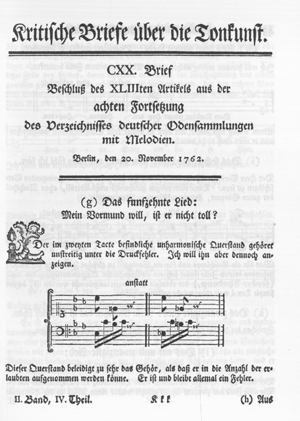Kritische Briefe über die Tonkunst
Prepared by Ole Hass
Online only (2013)

The Kritische Briefe über die Tonkunst [Critical letters on music (KBR)] appeared in Berlin from 23 June 1759 to 17 September 1763, printed in Gothic font by Friedrich Wilhelm Birnstiel. The journal is organized in Briefe [letters indicating issues], Theile [parts] and Bände [volumes]. Of the three volumes published, only the first two were completed and each contain sixty-four eight-page issues. These Bände [volumes] are subdivided into four parts of sixteen issues each. Issues of the first volume appeared weekly from 23 June 1759 to 6 September 1760. The second volume started 20 June 1761 and ran with interruptions until 15 January 1763. Several letters from readers, published in the November 1762 issues are already dated January and February 1763, indicating that these issues probably appeared months after the stated publication date. Both volumes were completed with an index. A third, incomplete volume, not mentioned in Imogen Fellinger’s list of journals in MGG and not part of a 1974 reprint of the journal (Georg Olms, Hildesheim), appeared from 11 June 1763 to 17 September 1763, containing fifteen issues. All 143 issues are consecutively numbered in Roman numerals.
The journal was edited by the eminent and sharp-tongued music theorist, Friedrich Wilhelm Marpurg (1718-1795). Most of the issues are written in the form of letters, addressed to musical personalities of the day. This style becomes less pronounced with the second volume. Marpurg signs most letters with pseudonyms; he characterizes these in the first issue, addressed to Leopold Mozart, as members of a musical society responsible for the journal: Amisallos, Oikuros, Eysymperiphoros, Neologos and Hypographus. Issue no. twenty-two of volume one appears as a letter to Marpurg himself, even though only the opening essay is a letter by Christian Gottfried Krause, a member of the Berlin Lieder School; the rest of the issue is by the editor himself.
Each issue usually contains one article only, and these articles are often printed in series over many weeks. In addition, issues of the first volume often contain a piece of music printed on the final one or two pages, either for keyboard or, more often, an “Ode.” Marpurg preferred the term “Ode” to “Lied” (song). The journal features a number of in-depth treatises on various musical subjects: (1) The mathematical derivation of equal temperament, including an introduction to mathematical fractions, in response to writings by Georg Andreas Sorge about the calculations in this field by Christoph Gottlieb Schröter, and (2) a theory of meter and rhythm. Of great depth are courses in the composition of (1) a fugue, (2) an ode or song, including an explanation of form in poetry, and (3) a recitative, including an introduction to grammatical and rhetorical punctuation and its expression in music. Marpurg also translated François Raguenet’s comparison of French and Italian opera, Paralléle des Italiens et des François en ce qui regarde la musique et les operas [Parallels of the Italian and French, in regard to music and the operas], with a remark on an earlier translation of the text by Johann Mattheson.
Writings by Marpurg on other topics give the individual installments greater independence: (1) an essay of a musical library, with reviews of works by authors including Johann Mattheson and Wolfgang Caspar Printz; (2) a critical inventory of collections of odes; (3) biographical sketches, including translations from the Storia della musica [History of music] by Giovanni Battista Martini and sketches on the musical theorist Jacob Adlung, the organ player Christoph Gottlieb Schröter, and the Swiss officer and musician, Franz Josef Leonti Meyer von Schauensee; and (4) notes on the writings by composers from the sixteenth and seventeenth centuries, such as Elias Nikolaus Ammerbach and Johann Georg Ahle.
Of the last twenty-three issues, twenty-one are titled “Beyträge zur Historie der Musik” [Contributions to a history of music], with biographical and bibliographical information as well as definitions of musical terms from Marpurg, Conrad Wohlgemuth, Johann Lorenz Albrecht, Johann Carl Conrad Oelrichs, Georg Gottfried Garbe and Friedrich Wilhelm Riedt. Also included here is a three-issue article by Christoph Gottlieb Schröter in which he claims to be the inventor of the pianoforte in 1717, including drawings of his original designs.
Marpurg’s pugnacious temperament led him to heated verbal exchanges with fellow music theorists Georg Andreas Sorge and Johann Philipp Kirnberger. In reaction to an announcement by the flutist Johann Joachim Quantz that no third part could be composed to his duets, Kirnberger performed a bass part to one of those duets during a church service attended by both theorists, and had sent a note about his achievement to the Kritische Briefe under the name of Peter Kleinlieb. An anonymous “Paul Dreyklang” [Paul triad] writes a response to Kirnberger in the following issue. A review in the journal of a fugue in D major by Kirnberger, written by an anonymous critic, later referred to as “Sechsstern” [Six stars, since the review is signed with six stars (asterisks)], is followed later with a rebuke by the same writer of Kirnberger’s retorts outside the journal.
The RIPM publication was prepared using the above-mentioned reprint by Georg Olms, Hildesheim for the first two volumes; the third volume was prepared from a copy at the Library of Congress, Washington, D. C.
